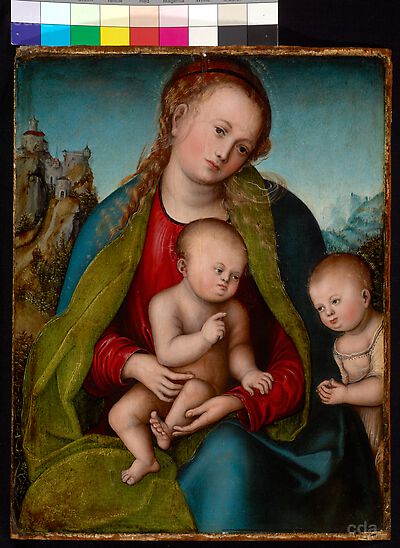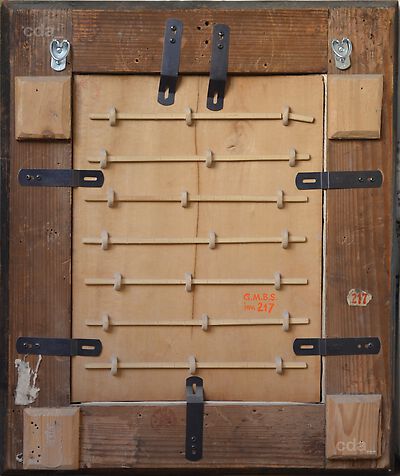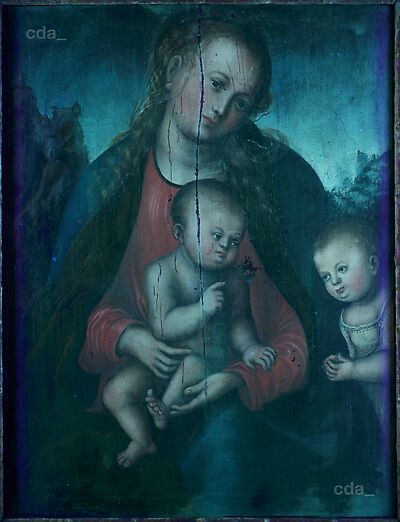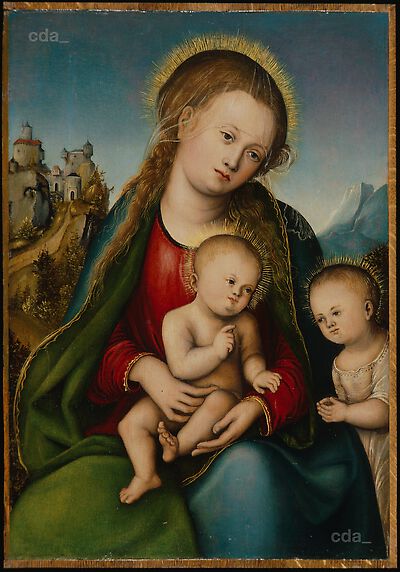The composition of this monumental work, which in a letter dated October 2, 1962 Walther Scheidig considered to be unique among the works of Lucas Cranach the Elder [Tarangul 1966, 343], combines clarity with a non-coercive organization: the figures are grouped into a pyramid formation, whose vertical axis is accentuated by the Virgin with the Child in her arms, but the introduction of a geometrical rigidity, achieved by the subtle parallelization of the anatomical lines of the Virgin and of the Child needed to focus the attention on the two characters, is avoided by the lateral position of John the Baptist [Hrib 2007, 131-132; Hrib 2011, 19, 21]. The background scenery with cliffs and castles is typical for Lucas Cranach the Elder. The blue sky without clouds has the dual role of emphasizing distance in order to create the illusion of perspective and highlighting the slightly tilted Virgin’s head that is of a delicate beauty and has a serene and gentle, but melancholic and somewhat enigmatic expression. Her golden, dishevelled hair, falling over her shoulders, is girded with a black headband and partially covered with a gauzy veil. Since the age of Albertus Magnus the Virgin’s hair colour became an object of controversy, and the artist’s option for the golden colour was considered to be a metaphoric way of emphasizing the perfection of the character’s female beauty (her face being considered as one of the most beautiful female portraits made by the artist), while still adhering to an aesthetic canon: the skin is white, highlighted by pink touches, the physiognomic features are harmoniously arranged, the nose is long, the lips are thin and red, but by contrary any other detail of the rest of her body is missing [Hrib 2007, 132; Hrib 2011, p. 20]. The bodies of the two children are anatomically well rendered, but are disproportionate, as the head corresponds to nearly a quarter of the body length. Their gestures suggest a discussion and their mature look are also unnatural, as John the Baptist, shy and afraid, however a little wag, is worshipping Jesus. The symbolic gestures of the children, highlighted by the expression of their different attitude are however compensated by the naturalistic position of the Virgin’s hands. They are highlighted as well by colour effects, which focus the viewer's attention on Mary by reducing the dominant blue hue to the vibrant red of her shirt with the intermediate application of green from the borders toward the centre. The fluid drawing, the harmonic blue and green tones of the Virgin's mantle, the beauty of her face shielded by the blue sky reinforce the artistic value of the work, which generally shows the characteristic style of the young painter, influenced by the art of the Italian Renaissance, which are obvious in the development of the Danube School. These aspects were mentioned in the dispute over the attribution of this painting to either Lucas Cranach the Elder or to his workshop, which arose due to the somewhat opaque appearance of the handling of the garments and to the monumental, but cumbersome composition.
Lucas Cranach the Elder had a large workshop and many of his works exist in several versions, some subjects were taken up again later by the artist himself, after several decades by Lucas Cranach the Younger or by various epigones, making it generally difficult to discern the true attribution of a work [Tarangul 1966, 340]. The rendering of the macrocephalic children is found not only in the works of the Cranach the Elder’s workshop, but even in his own works, whether signed or undoubtedly or with very high probability assigned to him, such as that so much discussed formerly as an analogy, once in the ducal collection of Altenburg, later (1932) in the collection of David Birnbaum in Amsterdam and since 1990 at the Royal Scottish Academy. This detail is in fact reminiscent of the late Gothic models, as well as the tortuous drawing, as remarked by T. Ionescu, who listed some deficiencies typical of the artist’s depiction of the Virgin: anaemic vitality, fake naïve look, affected grace and pretentious elegance [Ionescu 1967, 53]. In the background of many of the works with figures presenting these anatomical features there is a landscape dominated by a castle, but this element alone cannot be considered a typical feature of the great German painter, because it was picked up by numerous of his imitators. The work of Amsterdam (dated c. 1520), arrived later at the Wallraf-Richartz- Museum in Cologne, was compared in 1932 by Max J. Friedländer and Jakob Rosenberg with the painting from Sibiu [Friedländer, Rosenberg 1932, 51, No. 112] and later by T. Tarangul [Tarangul 1966, 339-340], is actually a variant of the painting from Statens Museum for Kunst in Copenhagen [oil on wood, 36.5 x 27.5 cm no. inv. KMS 3674], which was dated c. 1512-1514, so about at the time when Al. Gh. Sonoc [unpublished work] thinks that the painting from Sibiu could be dated and when are dated as well the oldest versions of the representation of the Virgin Mary with the infants Jesus and John the Baptist created by the artist [Schade, Gronau 1973, 57]. The extent to which the work in Copenhagen can be attributed to Cranach the Elder, to his workshop or produced with the participation of his workshop is the subject of a similarly animated discussion as that of the authorship of the picture in Sibiu, which shows that such opinions may still be an object of debate.
[Dr. Alexandru Gh. Sonoc, Muzeul National Brukenthal, revised 2017]




